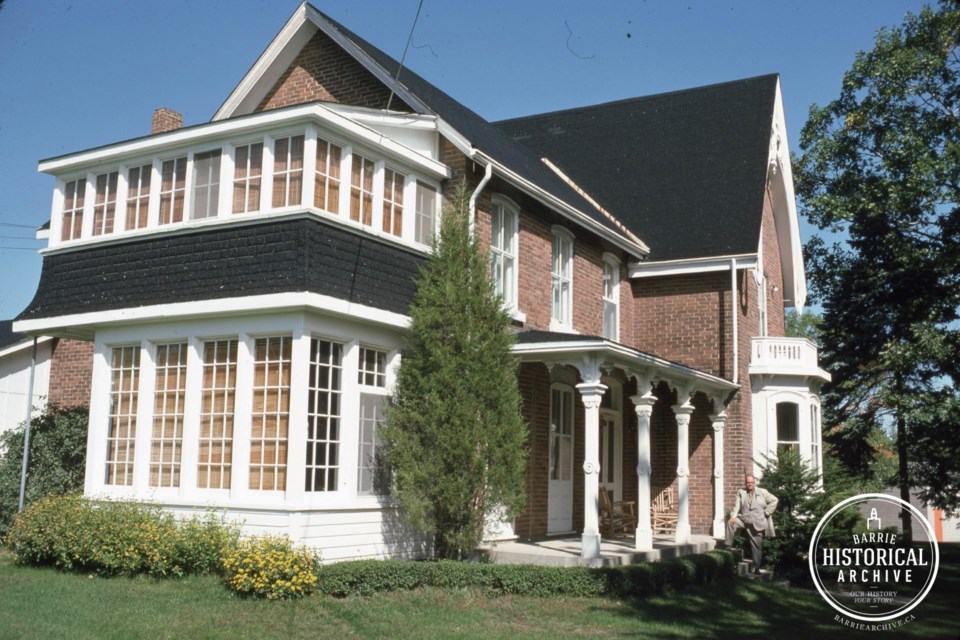This ongoing series from Barrie Historical Archive curator Deb Exel shows old photos from the collection and one from the present day, as well as the story behind them.
Three Oaks – 126 Letitia St.
Once you’ve discovered this astonishingly beautiful property, you might just agree that it’s one of Barrie’s best-kept historical secrets.
This magnificent Gothic revival farmhouse was built about 1874 for Alexander McKenzie, a Dunlop Street watchmaker and commanding officer of the Simcoe Foresters from 1869 to 1882, his wife Sophia and their two sons, Kenneth and Charles. The Canada Permanent Loan and Savings Company issued the $800 mortgage to the McKenzie’s for their parcel of land.
McKenzie was born in 1831 in Quebec, to Alexander and Charlotte. His father, a sergeant, served under the Duke of Wellington and his grandfather fought in the battle of Waterloo, among other confrontations. Alex’s own deep attachment to life in the field and camp, clearly came from his family’s strong military background.
McKenzie arrived in Barrie about 1847. In 1854, he joined the Active Militia of Canada and became a member of Simcoe County’s first Company. Within the 35th Simcoe Battalion of Infantry, McKenzie was an active participant and advocate, quickly rising through the ranks. When their Owen Street armoury burned in 1862, Captain McKenzie applied to Barrie council to use part of Market Square for drill practices until a replacement building could be constructed.
In 1869, Major Alexander McKenzie was appointed lieutenant colonel of the 35th Battalion Simcoe Foresters, their name having been changed in 1867. About a month later, McKenzie posted an invitation in the local newspaper:
CHALLENGE
Ten officers, Non Commissioned Officers and Privates of the Volunteers of Barrie, challenge ten civilians of Barrie to a FRIENDLY RIFLE MATCH. Conditions: Ranges – Two, Four, and Six Hundred Yards. Five rounds at each range. Civilians may use any rifle except the Government Issue.
In the spring of 1882, the Simcoe Foresters, along with armies and militias from across Canada, were called to assist in the Northwest Resistance. Lt. Col. McKenzie was appointed superintendent of the Northwest Mounted Police, a new career he was ready to embrace, although he was reluctant to leave his family and so many friends behind. A crowd, including his elderly father, gathered at the Barrie train station to see him depart for his new post. Waving farewell from the rear of the train to the cheering throng, would be last time his family and townsfolk would ever see Alexander McKenzie.
At Prince Arthur’s Landing, while on route to Duluth, Lt. Col. Alexander McKenzie, 50, died of a strangulated hernia.
Once again, an enormous crowd gathered at the Barrie train station, to meet the body of Lt. Col. McKenzie, only a few weeks after his enthusiastic send off. Hundreds of people filed through the drill shed at Queen’s Park, where McKenzie lay in state, to pay their respects, prior to the funeral. The procession, thought to have been the largest ever witnessed in Simcoe County, was estimated at over a mile in length.
Forming the slow, solemn march up Sunnidale Road were McKenzie’s military escort, the 35th Battalion Band, mourners, officers and men in uniform — some who had served with Alex — the mayor, members of city council, the sheriff, county judge and other county officials, the clergy, carriages and the general public, on foot.
Once at the cemetery, an observer writes, “and when they lowered the coffin in the grave there were few dry eyes in all that vast assemblage. The last rite was read, the last song was sung: the firing party performed their part of the ceremony, the last sod was placed, to the beat of the muffled drum the last mourner turned away and only a mound of earth marked the last resting place of one of Simcoe’s noblest sons, of one she delighted to honour in as much as he honoured his abiding place."
A monument to Lt. Col. McKenzie stands on his grave at Barrie Union Cemetery.
The urban legend goes that McKenzie never actually lived in his stately home, Three Oaks. Vespra Township assessment rolls show seven people, one cow and one horse residing at the residence in 1876.
As is often the way with large estates, or a five- acre park lot in the case of the McKenzie property, parts were sold off over time.
The site on which Portage View Public School now stands was once McKenzie land. The house is a particularly fine example of the architecture of its day, a Victorian red brick L-shaped Ontario farmhouse design. The ornate barge board in the steeply pitched gable adds a Gothic element and the splendid veranda woodwork gives the lovely home a gracious feel and character.
Much of the original features – doors, windows, flooring, fireplaces, staircase, ironwork, as well as the barn – are still intact. The charming two story sun room was likely a later addition to the house.
The current owners are exceedingly thoughtful and respectful guardians of this extraordinary heritage home with its important ties to Barrie’s history and historic citizen.
This elegant dwelling is a 2019 Heritage Barrie Award recipient.



